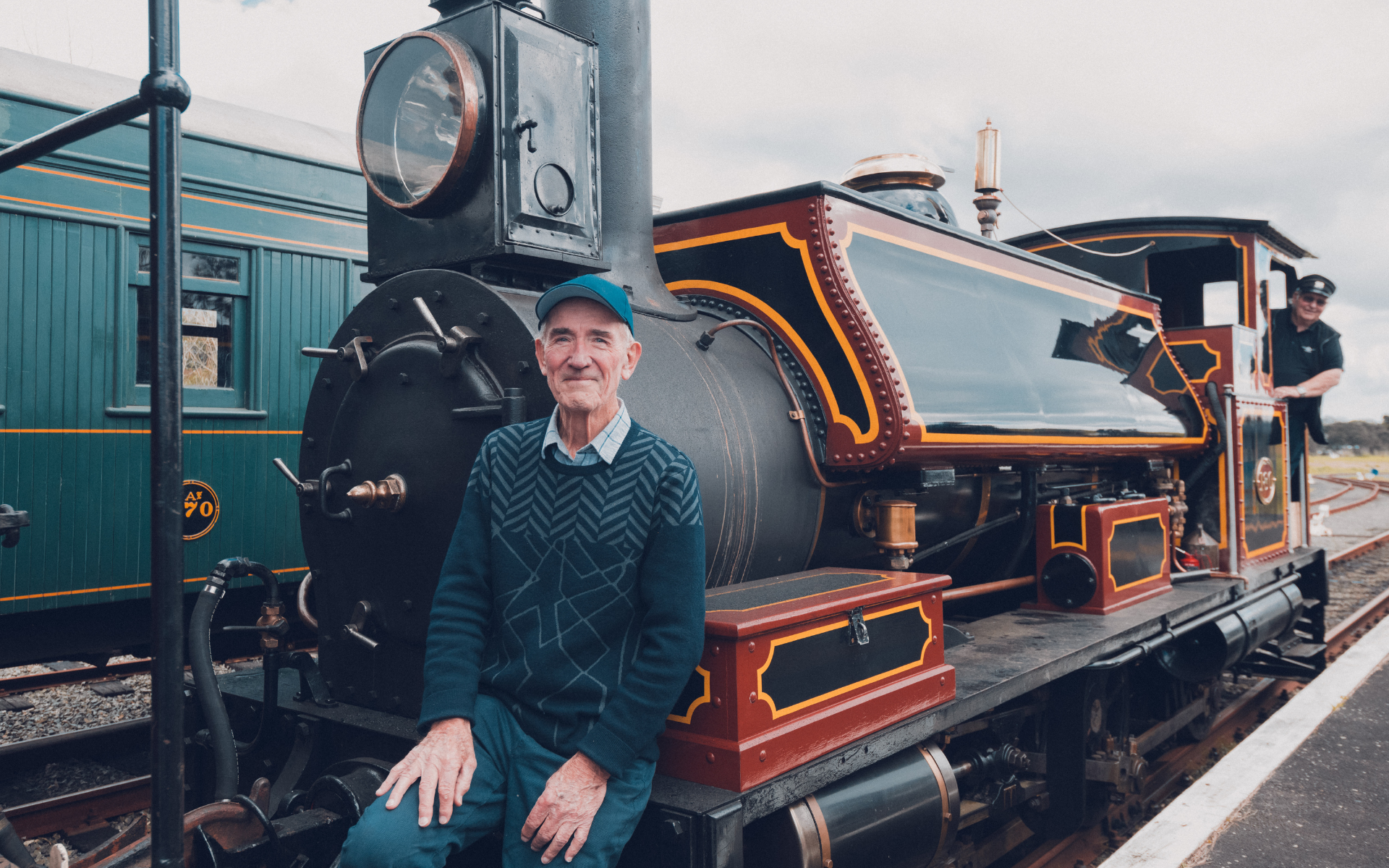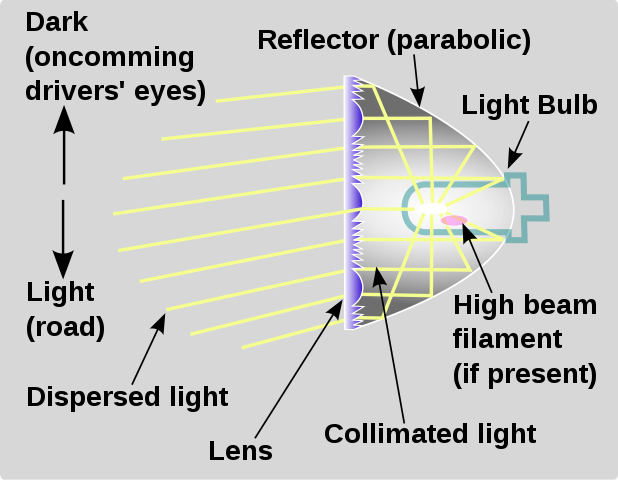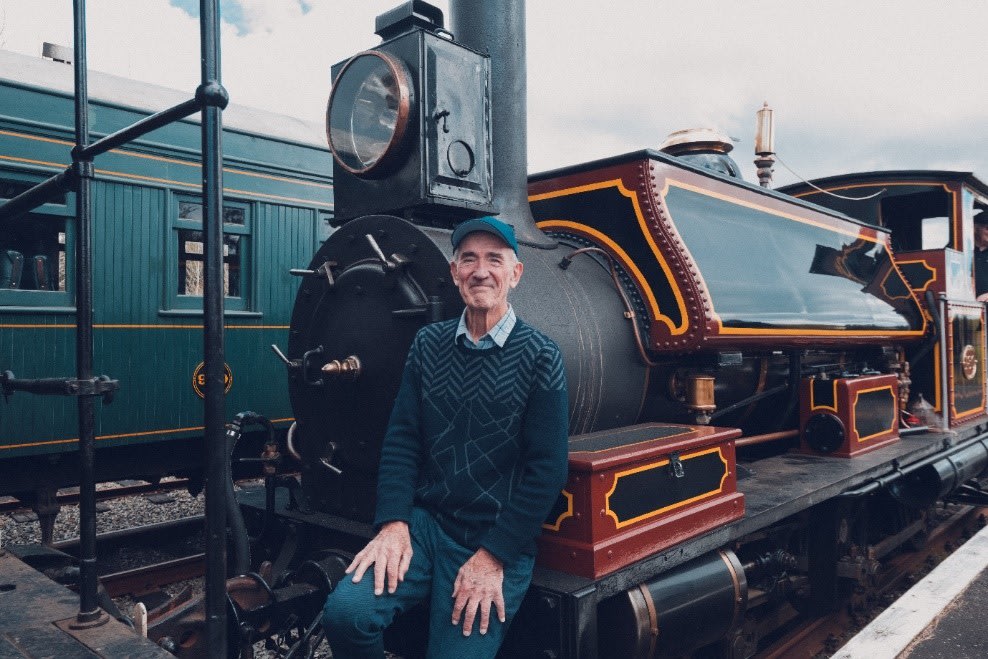MOTAT’s Well-Travelled Locomotive Oil Headlamp

Railways tell a history of transporting goods and people, but also a story of how technology has evolved to create a safe experience for railway operators and the wider public. In the MOTAT Collection, there are many wonderous objects to reveal the stories of railways in Aotearoa.
Let’s look at the oil headlamp fitted to our locomotive F180, an object which has served as an important safety feature on several of New Zealand’s locomotives from the 19th century to today. We’re picking this headlamp because of its placement on F180 ‘Meg Merrilies’ - a locomotive celebrating 4 years of being operational thanks to significant restoration work by MOTAT’s Rail Workshop Team.
Lighting the track
Headlamps have been utilised on New Zealand’s locomotives since the early 1870s and are primarily used to illuminate the track ahead. They allow locomotive crews to be able to see any potential obstructions on the track, as well as to ensure the oncoming locomotive is visible to railway staff, pedestrians, road traffic, and livestock. In the United Kingdom, headlights were generally not used in this manner as most railways were fully fenced and consequently locomotive crews could, as a rule, rely on the track being clear. However, in places such as New Zealand, the United States, and Australia, railway fencing was uncommon and thus solutions had to be found to improve safety. Whilst New Zealand Locomotives of the period were often built in the United Kingdom, they were either fitted from new or relatively quickly fitted with headlights and cowcatchers to help alleviate these issues.
The earliest record of attempts to illuminate the track ahead of a locomotive date from the 1830s with a bucket or basket of oil or wood being placed ahead of the locomotive and ignited to create light. Soon purpose-built lamps started being made, burning whale oil, and later kerosene. In these lamps, the oil is held in a tank and is drawn up by a wick, at the top of which it is burned to create light. On locomotives the wick is generally tubular in shape to allow additional air to circulate in the centre of the flame, increasing the amount of oil that can be cleanly burned. The light created by the burning oil is then focused by a parabolic reflector, creating a narrow and relatively intense beam of light directed at the track ahead. This is the sort of lamp fitted to F180 and is the focus of this article.

Below, you can see the parabolic reflector in the lamp on F180 behind the glass pane on the front. It is a silver parabolic dish, like that in the diagram, which shows how the light from a wick (or bulb, in the case of an electric lamp) is bounced off a reflective surface to focus the light.

As technology progressed various other forms of lighting started to be employed to try and improve locomotive headlamps. Oil lamps were, in New Zealand and many other places, largely superseded by lamps fuelled by acetylene gas. Acetylene was created on board the locomotive in a special generator that allowed droplets of water to fall onto calcium carbide, releasing the acetylene gas which was then piped to the lamps where it could be burned. These lamps were smaller, brighter, and somewhat more reliable than the oil lamps which they replaced. In New Zealand, they were introduced in the early 1900s and were ultimately phased out between the 1920s and the mid-1940s with the introduction of electric lights. MOTAT holds two acetylene headlamps and an acetylene generator in its collection — one of the lamps currently being fitted to locomotive L507.
At the same time as acetylene lamps were first being introduced, trials with electric lighting of locomotives were also happening in New Zealand. These utilised steam turbines to generate electricity. These turbines had been developed during the 1890s but early attempts to harness this power were problematic. Light bulbs of the period were fragile, and the vibration and movement of a locomotive were enough to break the filament in the bulb rendering it useless.
The other option was to use a carbon-arc lamp, where the light is created using an ‘arc’ (essentially a big continuous spark) between a set of carbon electrodes. Such a lamp was trialled in New Zealand on locomotive A71 but did not prove successful and locomotives continued to be built with oil and acetylene headlights.
The breakthrough for electric lighting was the development in 1913 of tungsten filaments for light bulbs, creating a bulb that was robust enough for reliable use on locomotives. As a result, electric lighting became the norm in New Zealand from the 1920s onwards and older forms of lighting were gradually phased out. The standard electric lighting on New Zealand’s steam locomotives generally consisted of turbo-generators and headlamps provided by the Pyle National Company of Illinois. MOTAT’s locomotive Y542 is currently fitted with a set of this equipment.
Today all locomotives in use on the national railway network must be fitted with electric headlights, with modern diesel and electric locomotives being fitted with sealed-beam headlights. As an additional safety measure, they also must be fitted with flashing ditch lights which are used on approaching level crossings and stations to provide a warning of the train’s approach.
Meg’s well-travelled oil lamp
Meg’s lamp arrived at MOTAT with little known history. Luckily this lamp is of an unusual design and has several distinguishing features that have, over some time, allowed additional information about its history to be discovered. As received by MOTAT, the lamp:
Was painted a distinctive shade of green paint, as was used on locomotives F13 and F163 in the 1960s
Has the pane of glass on the front mounted higher than most other NZR oil lamps
Has a short, boxy chimney
Has side panels that are a unique shape
Most importantly of all, has an obvious repair on the door- a patch at the bottom with a row of very prominent rivets.
Based on the lamp’s green paint scheme and an examination of photographs, it was revealed that the lamp was indeed fitted to F13 during the 1963 Railway Centennial exhibition in Christchurch. Moving further back, it was soon discovered that it also had been fitted to F180 during the 1960 Taumarunui Jubilee, and before that to Wa68 during the Palmerston North 75th Jubilee in 1952.

Little more was known about this lamp until 2020 when analysis of a photo of locomotive Wh448 revealed that it carried the same lamp with its patch on the door. This locomotive was formerly Wellington & Manawatū Railway Co. No.2 and had been acquired by the New Zealand Government Railways (NZR) at the end of 1908 when they purchased the assets of that company. The WMR had previously been formed in 1881 by a group of Wellington businessmen after the Government of the time rejected a proposal to build a railway through the Manawatū. They were subsequently very successful and operated 22 locomotives hauling trains between Wellington and Longburn.
A further examination of WMR photographs suggests that before being fitted to WMR No.2, the lamp was most likely imported with either WMR No’s 13 or 14 (later NZR Oa 457 and Na459). These locomotives were manufactured by the Baldwin Locomotive Works of Philadelphia and were imported in 1893 and 1894 respectively.

Consequently, the lamp is thought to have been carried by:
WMR 13 or WMR 14 from 1893 or 1894 (later renumbered by NZR as Oa457 and Na459 respectively)
WMR No.2/ NZR Wh448
Wa68 in 1952
F180 in 1960
F13 in 1963
L507 at MOTAT from 2008 to 2015
F180 at MOTAT from 2018
This is not an exhaustive list and there is a very real chance that the lamp has been carried on other locomotives during its life. Its use on Wa68, F180, and F13 was purely decorative, the intent being to show those locomotives as they were earlier in their lives. The lamp is thus not likely to have been regularly used since the 1910s. At some point it has lost its original burner assembly, this being replaced by a burner from the more common type of box lamp used by NZR — this has had to be raised with a packer to align it with the front lens. Today the lamp remains an interesting example of old locomotive lighting technology, complete with its colourful history.
Want to see more of Locomotive F180 'Meg Merrilies'? Check out Collections Online items here.
Story by Graham Anderson, Collection Workshops Manager, MOTAT.
Citation:
Anderson, Graham, 2022. MOTAT Museum of Transport and Technology. Published: 4 August 2022. URL: https://www.motat.nz/collections-and-stories/stories/motats-well-travelled-locomotive-oil-headlamp